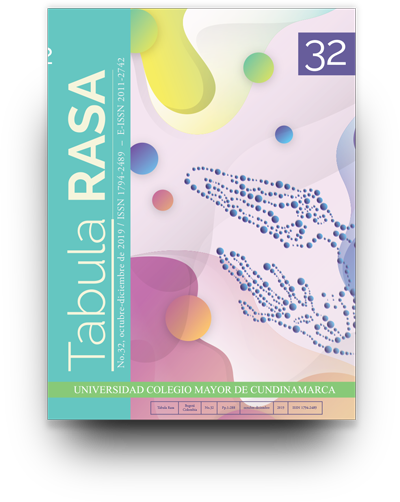That special relation to cats and dogs : the multispecies family and its metaphors.
Esa relación tan especial con los perros y con los gatos : la familia multiespecie y sus metáforas.
Show authors biography
This research paper analyses the social constructs of the contemporary relation with cats and dogs in urban settings. In order to do this, it resorted to an ethnographic study by observing the practices kept by families towards those species in various settings in the city of Bogotá. This is supported by human-animal studies in combination with a social constructionism approach. The main finding is that the integration based on affection of cats and dogs to the so-called multispecies family is imbued of a series of metaphorical meanings, sometimes ambiguous and conflicting, which help explain the complexity and multidimensionality of human-animal relations. The study arrives to the conclusion that people do continuously acknowledge the importance of affection and the social roles performed by these animals. However, a limited and often misguided understanding of the place of animals in their relation to humans is observed. Therefore, acknowledging cats and dogs as individual beings with their own experiences and interests is encouraged.
Article visits 245 | PDF visits 262
Downloads
- American Pet Products Association (APPA). (2019). APPA News & Industry Headlines. Recuperado de: http://www.americanpetproducts.org/
- American Pet Products Association (APPA). (2016). Welcome to the American Pet Products Association (APPA). Recuperado de: http://www.americanpetproducts.org/
- American Veterinary Medical Association (AVMA). (2016). U.S. Pet Ownership Statistics. Recuperado de: https://www.avma.org/Pages/home.aspx
- BBC Mundo. (2014). BBC Mundo - Noticias - En medio de la crisis, las mascotas de EE.UU. viven como reyes. Recuperado de: http://www.bbc.com/mundo/noticias/2012/03/120304_economia_mascotas_eeuu_tsb.shtml
- Beck, A. M., & Katcher, A. H. (2008). Future directions in human-animal bond research. En C. P. Flynn (Ed.), Social creatures: A human and animal studies reader (pp. 49-58). New York: Lantern Books.
- Beck, A. M., & Katcher, A. H. (1996). Between pets and people: The importance of animal companionship. Indiana: Purdue University Press.
- Berger, P. L., Luckmann, T. (1991). La construcción social de la realidad (Vol. 975). Buenos Aires: Amorrortu.
- Clutton-Brock, J. (2012). Animals as domesticates: a world view through history. Michigan: MSU Press.
- Cohen, S. P. (2002). Can pets function as family members? Western Journal of Nursing Research, 24(6), 621–638.
- DeMello, M. (2012). Animals and society: an introduction to human-animal studies. New York: Columbia University Press.
- Flynn, C. P. (2008). Social creatures: A human and animal studies reader. New York: Lantern Books.
- Fox, R. M. (2006). Cultural geographies of pet-keeping (Doctoral dissertation), Royal Holloway, University of London, England.
- Haraway, D. J. (2003). The companion species manifesto: Dogs, people, and significant otherness. Chicago: Prickly Paradigm Press.
- Ingold, T. (1988). What is an animal? London: Routledge.
- Johnson, J. (2009). Dogs, Cats, and Their People: The Place of the Family Pet and Attitudes about Pet Keeping (Master’s tesis), University of Waterloo, Canada.
- Lizcano, E. (1999). La metáfora como analizador social. Revista de Metodología de Ciencias Sociales, 2, 29-60.
- Mullin, M. H. (1999). Mirrors and windows: sociocultural studies of human-animal relationships. Annual review of anthropology, 28(1), 201-224
- Noske, B. (1993). The animal question in anthropology: A commentary. Society and Animals, 1(2), 185–190.
- Power, E. (2008). Furry families: making a human–dog family through home. Social & Cultural Geography, 9(5), 535–555.
- Ritvo, H. (1987). The animal estate: The English and other creatures in the Victorian age. Cambridge: Harvard University Press.
- Secretaria de Salud de Bogotá, D. C. (2013). Consolidado de los resultados finales del estudio para estimar las poblaciones de perros y gatos en las localidades del D.C. Bogotá.
- Serpell, J. (1996). In the company of animals: A study of human-animal relationships. Cambridge: Cambridge University Press.
- Shapiro, K. J. (2008). An introduction to human animal studies. En C. P. Flynn (Ed.), Social creatures: A human and animal studies reader (pp. 3-6). New York: Lantern Books.
- Tronto, J. C. (1993). Moral boundaries: A political argument for an ethic of care. New York & London: Psychology Press.
- Tuan, Y. F. (1984). Dominance & affection: The making of pets. New York: Yale University Press.








